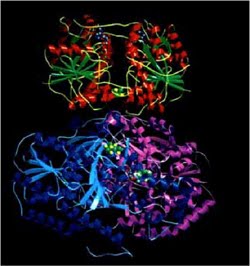A report in ScienceDaily shows how fine-tuned biological logic can be--even down to the way a single electron is used in a strange but smart way to achieve the desired result with maximum efficiency.
The enzyme photolyase, which is naturally produced in the cells of plants and some animals (but not in mammals, including humans) repairs DNA by damaged by sunlight by tearing open the misshapen, damaged area in two places and reforming it into its original, undamaged shape.
But the enzyme does not break up the injury in both pieces at once. It is a two-step process that sends a single electron through the DNA molecule in a circuitous route from one breakup site to another.
Ultraviolet (UV) light damages DNA by exciting the atoms in the DNA molecule, causing accidental bonds to form between the atoms. The bond is called a photo-lesion, and can lead to a kind of molecular injury called a dimer. Dimers prevent DNA from replicating properly, and cause genetic mutations that lead to diseases such as cancer.
The dimer in question is called a cyclobutane pyrimidine dimer, and it is shaped like a ring that juts out from the side of the DNA.
For those organisms lucky enough to have photolyase in their cells, the enzyme absorbs energy from visible light--specifically, blue light--to shoot an electron into the cyclobutane ring to break it up. The result is a perfectly repaired strand of DNA.
skip to main |
skip to sidebar



Thoughts on the fundamental logic--i.e., the molecular logic--of life, plus other life items (the first are copied from my EStar blog, from 2006 onwards). The foundation of life is the logic of the atom; built on that is the logic of the molecule; built on that is the logic of the cell; built on that is the logic of the organ; built on that is the logic of the organism.


Popular Posts
-
This article from the online entity of Science , published by the American Association for the Advancement of Science, is yet more proof of ...
-
THE REAL ORIGIN OF SPECIES — BIODEVELOPMENT — by NOBILANGELO CERAMALUS (pronounced noble- arn -jillo kerra- mar -liss) Member of the Americ...
-
Using very fine electrodes, researchers have revealed some of the astonishing processing-power of a single human neuron. Full story at ht...
-
Bio-molecules are network processors. A cell is a collection of molecular network processors. The individual processing is affected by the b...
-
This article gets close to saying what this blog has been saying for years . Bio-molecular logic and processing operates over the aeons to ...
-
As this blog has been saying for years, the so-called 'junk' DNA is not junk. To use computer terms, DNA is CPU, RAM, disk drive, o...
-
The process of transcribing DNA instructions into proteins has now been found to be a lot smarter than previously imagined. A detailed com...
Total Pageviews
NOTE ON TOTAL PAGEVIEWS
Blogger's statistics have not been operating since the start of this blog. Only since mid 2009.
About Me

- Nobilangelo
- My Christian name is pronounced 'noble-arn-jillo' (i.e., both o's are long, so the first two syllables rhyme with 'noble' not 'hobble'--yes, I know that's obvious, because there's only one 'b' between the 'o' and the 'i', but some people seem to see two b's, hence the English lesson). My surname is pronounced kerra-marliss. I was born, bred and educated in New Zealand, except for an international systems-engineer's course in San Antonio, Texas. I am born-again Christian, a thinker with a very practical turn of mind, a scientist with a particular interest in planet-friendly energy and neuroscience, an engineer (mechanical, industrial and IT systems), an inventor, a Member of the American Association for the Advancement of Science, a writer and poet, a naturist, a designer in different fields, an arranger and composer of symphonic music, a multi-award-winning IT journalist, a photographer, and a practitioner at various times in other hands-on fields including building, metalwork, woodwork, stained-glass and landscaping.